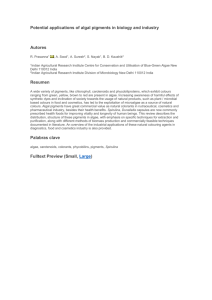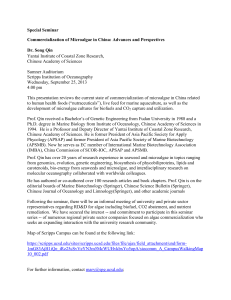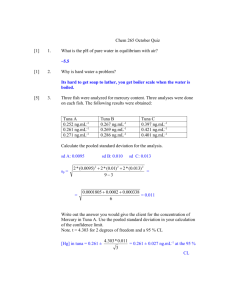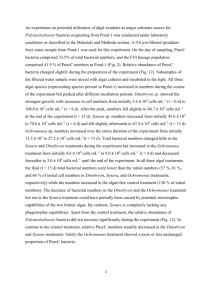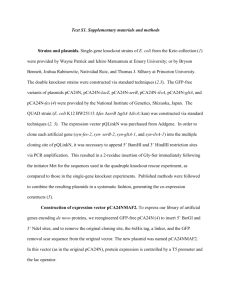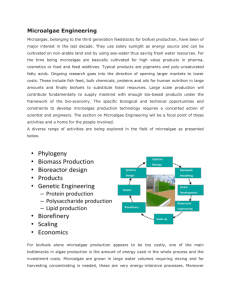PPT Version - OMICS International
advertisement
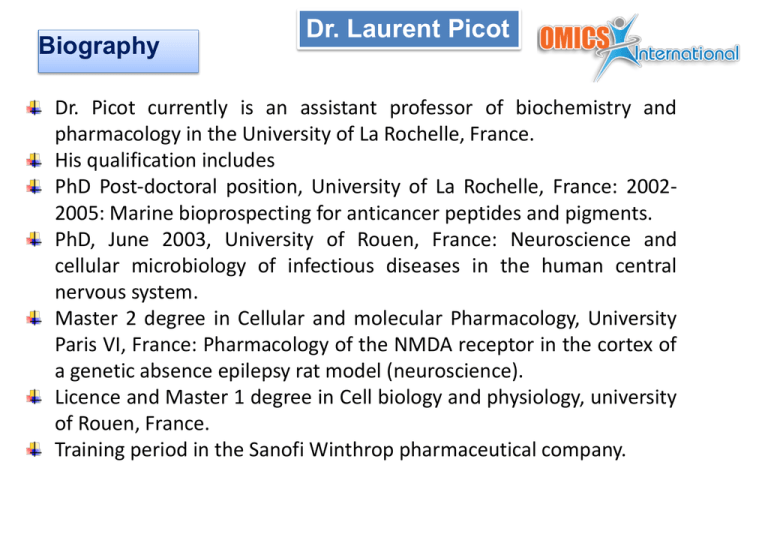
Biography Dr. Laurent Picot Dr. Picot currently is an assistant professor of biochemistry and pharmacology in the University of La Rochelle, France. His qualification includes PhD Post-doctoral position, University of La Rochelle, France: 20022005: Marine bioprospecting for anticancer peptides and pigments. PhD, June 2003, University of Rouen, France: Neuroscience and cellular microbiology of infectious diseases in the human central nervous system. Master 2 degree in Cellular and molecular Pharmacology, University Paris VI, France: Pharmacology of the NMDA receptor in the cortex of a genetic absence epilepsy rat model (neuroscience). Licence and Master 1 degree in Cell biology and physiology, university of Rouen, France. Training period in the Sanofi Winthrop pharmaceutical company. Research Interests Marine and terrestrial Biochemistry and Pharmacology Biotechnology of marine resources Anticancer molecules Marine microalgae, pigments Major achievements 2014 Demonstrated the possibility to extract phycobiliproteins microalgae using Microwaves-assisted extraction. from marine 2014 Developed and optimized an extraction process to purify carotenoids from marine microalgae. 2013 Identified zeaxanthin and b-cryptoxanthin from Cyanophoara paradoxa as potent inhibitors of human invasive melanoma cells growth 2012 Developed and optimized an extraction process to purify metabolites from marine microalgae 2012 Reviewed the potential of microalgae for the production of bioactive molecules of pharmaceutical interest 2012 Reviewed all the data demonstrating the anticancer activity of microalgal epoxycarotenoids 2011 Identified Violaxanthin from Dunaliella tertiolecta as a potent inhibitor of human breast cancer cells growth 2011 Performed the first Microwaves-assisted extraction of phytoplankton pigments in the world 2011 Demonstrated that microalgae pigments have a high potential as tumor photosensitizers (ANR Project Photomer) Selected papers from our research group • • • • • • • • Juin C., Chérouvrier J.R., Thiéry V., Gagez A.L., Bérard J.B., Joguet N., Kaas R., Cadoret J.P. & Picot L. Microwave-assisted extraction of phycobiliproteins from Porphyridium purpureum. Accepted in Applied Biochemistry and Biotechnology 2014 (http://www.ncbi.nlm.nih.gov/pubmed/25231233). Juin C., Thiéry V., Cadoret J.P. & Picot L. Towards the clinical use of Phytoplankton carotenoid pigments to cure cancer. Oceanography open access 1(3), 2013. Baudelet P.H., Gagez A.L., Bérard J.N., Juin C., Bridiau N., Kaas R., Thiéry V., Cadoret J.P. & Picot L. Antiproliferative activity of Cyanophora paradoxa pigments in melanoma, breast and lung cancer cells. Marine Drugs 11(11), 4390-4406, 2013. Serive B., Kaas R., Bérard J.B., Pasquet V., Picot L. & Cadoret J.P. Selection and optimisation of a method for efficient metabolites extraction from microalgae. Bioresource technology 124, 311320, 2012. Mimouni V., Ulmann L., Pasquet V., Mathieu M., Picot L., Cadoret J.P., Morant-Manceau A. & Schoefs B. The potential of microalgae for the production of bioactive molecules of pharmaceutical interest (review). Current Pharmaceutical Biotechnology 13(15), 2733-2750, 2012. Gagez A.L, Thiery V., Pasquet V., Cadoret J.P. & Picot L. Epoxycarotenoids and cancer (review). Current Bioactive compounds 8(2), 109-141, 2012. Pasquet V., Morrisset P., Ihammouine S., Chepied A., Aumailley L., Berard J.B., Serive B., Kaas R., Lanneluc I., Thiery V., Lafferiere M., Piot J.M., Patrice T., Cadoret J.P. & Picot L. Antiproliferative activity of violaxanthin isolated from bioguided fractionation of Dunaliella tertiolecta extracts. Marine Drugs 9(5), 819-831, 2011 Pasquet V., Chérouvrier J.R., Farhat F., Thiéry V., Piot J.M., Bérard J.B.,Kaas R., Serive B., Patrice T., Cadoret J.P. & Picot L. Study on the microalgal pigments extraction process: Performance of microwave assisted extraction. Process Biochemistry 46(1), 59-67, 2011. Oceanography is the science of oceans and seas including marine environment, coastal zone management, fishery economics, and marine pollution. Oceanography increases the scope of marine pollution impact and possible effects of the exploitation of marine resources, together with the role of the ocean in possible global warming and climate change. Oceanography: Open Access is an Open Access journal and aims to publish most complete and reliable source of information on the discoveries and current developments in the mode of original articles, review articles, case reports, short communications, etc. in all areas of the field and making them freely available through online without any restrictions or any other subscriptions to researchers worldwide Dr. Laurent Picot, Associate editor of Oceanography Open access Littoral Environment Society Environmental molecules and human health (UMRi CNRS 7266 LIENSs La Rochelle) Pigment extraction, purification, chemistry and pharmacology LP Our team has been working for years with IFREMER PBA Nantes lead by Dr Jean-Paul CADORET JPC Algae Physiology and Biotechnology (PBA Nantes) Microalgae culture, selection, molecular biology, biotechnology Location of the Labs : Nantes and La Rochelle, France The Labs : PBA IFREMER Nantes and UMRi CNRS 7266 La Rochelle, France Research and Methodology Our Research Isolate bioactive pigments from marine microalgae, develop innovative extraction and purification processes. Understand the biological and pharmacological activity of microalgae pigments in cancer cells Confirm the anticancer activity in vivo in animal models and validate the clinical interest of microalgae pigments Pharmacomodulate the bioactive molecules to optimize their activity and biodisponibility Clean and innovative pigments extraction processes Proliferation studies, apoptosis, videomicroscopy Murine models for melanoma and other tumors Chemical and Enzymatic modification Microalgae taxonomic diversity An example of one of our research projects : Isolation of an antiproliferative pigment from Dunaliella tertiolecta Selection of the species for this study unstudied for the purification of anticancer pigments available in banks and easy to grow in photobioreactors Possible extraction of pigments Dunaliella tertiolecta green Chlorophyceae The purpose get most pigments in a wide polarity range, work in non denaturating conditions for pigments extraction, check the reproducibility of extracts and define the pigment composition, optimize the pigments extraction yields Assess the anticancer activity of DT pigments IC50 of Dunaliella tertiolecta pigments extracts Cancer cell line Extract A549 (lung) Water EtOH > > DCM > Water EtOH DCM > 61,5 µg.ml-1 56,1 µg.ml-1 Water EtOH DCM Water EtOH DCM > > > > > 60,9 µg.ml-1 MCF-7 (breast) MDA-MB-231 (breast) LNCap (prostate) Dunaliella tertiolecta > means IC50 > 100 µg.mL-1 Dunaliella tertiolecta Dichloromethane extract MCF-7 RP-HPLC fractionation of Dunaliella tertiolecta DCM extract Ex trait Dichlorométhanique ExC trM ait e Dx icth loc rot méthanique D ra F1 F1 F2 F2 F3 F3 F4 F4 Chromatogram at 435 nm Dunalliela tertiolecta Dichloromethane extract Fraction MCF-7 IC50 (µg.ml-1) F1 F2 F3 F4 14,3 > > > F1 > IC50 > 100 µg.ml-1 RP-HPLC sub-fractionation of Dunaliella tertiolecta Fraction 1 F1 F1 Fraction F1 F1.3 F1.1 F1.1 F1.2 F1.2 MCF-7 CI50 (µg.ml-1) sem + /- F1.1 F1.2 F1.3 F1.4 > 20,5 18,9 11,7 2,2 8,85 0,2 F1 F1.4 > IC50 > 50 µg.ml-1 Chromatogram at 435 nm F1.4 Dunalliela tertiolecta Dichloromethane extract Fraction 1 Molecular characterization of F1.4. Carotenoid pigment Band III/II ratio 96% One major peak in F1.4 corresponding to 95% of the fraction peak surface Molecular characterization of F1.4. High Resolution Mass Spectroscopy ESI Bruker MicrO-Tof-Q 2 Solvent : CH2Cl2 /CH3OH : 90/10 Formula C40H5604 violaxanthin neoxanthin prasinoxanthin siphonaxanthin Molecular formula [M+Na]+ (C40 H56 O4 Na) Theorical MW 623.40763 Experimental m/z 623.4068 (0 ppm) Molecular characterization of F1.4. Comparison with standard carotenoids The retention time of F1.4 is the same as standard violaxanthin and different from the 3 other pigments sample Rt (min) F1.4 13,963 Standard Violaxanthin 14,047 Molecular characterization of F1.4. Absorption maxima and Band III/II ratio are equivalent to that of standard Violaxanthin Sample Absorption spectrum 300 à 600 nm % III/II Absorption maxima (nm) 17,327Peak1 441,5 0,90 471,9 0,80 070 , 417,2 0,60 AU 0,50 F1.4 0,40 0,30 0,20 0,10 329,5 417,2 441,5 471,9 96 417,2 441,5 471,9 98 0,00 300,00 32000 , 34000 , 36000 , 380,00 400,00 42000 , 44000 , 46000 , 48000 , 500,00 520,00 54000 , 56000 , 58000 , 60000 , nm 17,438 Peak 1 441,5 0,038 471,9 0,036 0,034 0,032 0,030 0,028 0,026 417,2 0,024 0,022 0,020 AU Standard violaxanthin 0,018 0,016 0,014 0,012 0,010 0,008 0,006 0,004 0,002 329,5 562,3 0,000 300,00 350,00 400,00 450,00 nm 500,00 550,00 600,00 OH Conclusion F1.4 = violaxanthin O O HO Biological activity of Violaxanthin in MCF-7 breast cancer cells Induction of early apoptosis (translocation of Phosphatidyl Serines) and necrosis at 8 µg.ml-1 Antiproliferative IC50= 11,7 ± 0,2 µg.ml-1 = 18,5 ± 0,3 µM No internucleosomal fragmentation at 40 µg .ml-1 cytostatic at 40,0 µg.ml-1 = 63 µM pb M TT- 1 T+ V 40 2,5 0 µg.ml-1 0,1 µg.ml-1 1,0 µg.ml-1 10,0 µg.ml-1 40,0 µg.ml-1 Absorbance (=550nm) 2,0 3000 2000 1,5 Violaxanthine : 8 µg.ml-1 1,0 1500 1200 1000 900 800 700 600 500 400 300 200 0,5 100 40 0,0 Time (h) 0 20 60 80 OMICS International Open Access Membership OMICS International Open Access Membership enables academic and research institutions, funders and corporations to actively encourage open access in scholarly communication and the dissemination of research published by their authors. For more details and benefits, click on the link below: http://omicsonline.org/membership.php
